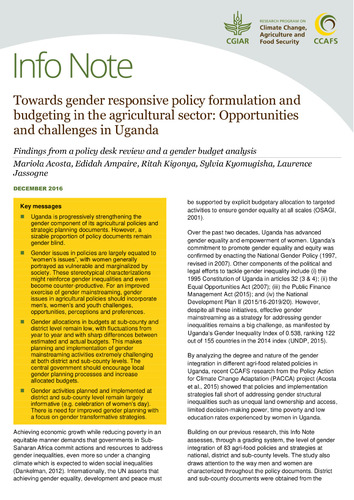Towards gender responsive policy formulation and budgeting in the agricultural sector: Opportunities and challenges in Uganda
Abstract
Achieving economic growth while reducing poverty in an equitable manner demands that governments in Sub-Saharan Africa commit actions and resources to address gender inequalities, even more so under a changing climate which is expected to widen social inequalities (Dankelman, 2012). Internationally, the UN asserts that achieving gender equality, development and peace must be supported by explicit budgetary allocation to targeted activities to ensure gender equality at all scales (OSAGI, 2001).
Over the past two decades, Uganda has advanced gender equality and empowerment of women. Uganda’s commitment to promote gender equality and equity was confirmed by enacting the National Gender Policy (1997, revised in 2007). Other components of the political and legal efforts to tackle gender inequality include (i) the 1995 Constitution of Uganda in articles 32 (3 & 4); (ii) the Equal Opportunities Act (2007); (iii) the Public Finance Management Act (2015); and (iv) the National Development Plan II (2015/16-2019/20). However, despite all these initiatives, effective gender mainstreaming as a strategy for addressing gender inequalities remains a big challenge, as manifested by Uganda’s Gender Inequality Index of 0.538, ranking 122 out of 155 countries in the 2014 index (UNDP, 2015).

